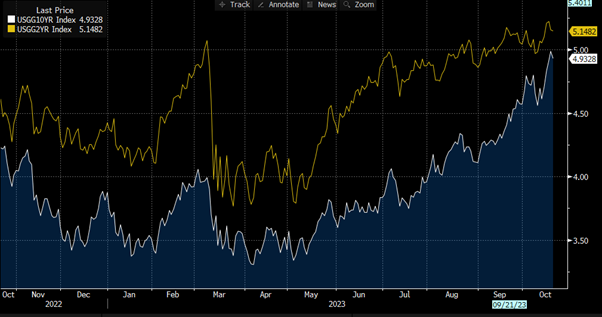This week 10-year Treasury yields broke through the 5% barrier. It came after comments from Federal Reserve Chair Jerome Powell suggesting there was scope for more rate rises. Investors are asking the same question they have been asking all year: What next?
To consider the options, it is helpful to find the answers to another question: Why did this happen?
The rise in 10-year Treasury yields has come on the back of stronger-than-expected US economic data.
Regardless of Powell’s hints, there is now a greater expectation of a pause in rate hikes, but with them remaining elevated for longer – what is called the ‘table top’ scenario. This has caused yield curves to steepen.
As the chart below demonstrates, two-year Treasuries have already spent some time this year above 5% – the expectation of a longer period of higher rates however has meant that 10-year Treasuries have now caught up.
Yields on 10yr vs 2yr Treasuries over the past 12 months

Source: Artemis
So will they stay at this level? Look at the continued strength of the US economy. Remember that most homeowners there are on 20-year mortgages and locked into low rates, and you begin to see how rising interest rates across the Atlantic might struggle to make the dent in inflation central bankers would like.
Ultimately there is little reason to believe that in the current environment of resilient economic performance, strong labour force dynamics and sticky core inflation that yields should fall meaningfully.
Shaping investor decisions
Looking beyond the uncertainty, higher yields on government bonds now offer two advantages to investors. There is the obvious point – they provide more yield, which can provide total returns to help insulate against further moves. However, there is also another point – the room for yields to tighten in a risk-off environment (say a global recession) is much greater than previously as we are simply starting from a much higher point.
Therefore, the key element is whether a large risk-off event occurs – most probably a US recession – which can allow the market to start thinking seriously about the Federal Reserve cutting rates, and therefore cause a rally in yields.
Unfortunately, I don’t have a crystal ball to predict this (or the skills to use one), but the benefit from a portfolio construction perspective of government bonds today given this potential diversification is much more meaningful than it was two years ago.
Impact on equities and currencies
Generally, higher Treasury yields caused by expectations of tighter monetary policy are negative for stock markets, positive for the dollar, and negative for the euro. This has been the case in moves since the mid-July low in Treasury yields, with the dollar strengthening against the euro and the S&P 500 falling.
The other related element is the shape of the yield curve – a portion of the bullish risk sentiment in the first half of 2023 was driven by an expectation that the Federal Reserve would soon start cutting rates, which should help equities perform. The steepening of the curve since July has seen some of those hopes of monetary policy loosening fade, which has hurt the performance of equities.
Portfolio positioning
For advisers and investment managers, the challenge at times like this is to build portfolios resilient enough to cope with a broad range of scenarios – with rates rising further, or being quickly reduced by panicking central bankers if it transpires they’ve tightened the screw too far.
Our fixed income team retains a broadly negative view towards duration exposure. Government bond yields globally have room to increase further. However, within this we think US government bonds have already moved quite a lot relative to other markets, and therefore there is a good case for taking on exposure to US government bonds rather than to other markets that have moved less, such as German government bonds.
We have a long position in US Treasury inflation protected securities (TIPS), which we believe have the room to perform in a risk-off move while also providing some attractive real yields – in other words, that are insulated against potential upside surprises in inflation.
Across fixed income more broadly, long-term investors look well compensated for being in the asset class today. Many investors understandably moved away from fixed income in the decade of artificially suppressed yields following the global financial crisis.
Today’s fixed income valuations offer attractive alternatives for investors looking for a diversified return stream within a broader portfolio that has a balance of bonds and equities. The future may look uncertain, but in this regard at least it feels like the world is returning to a more ‘normal’ past.
Toby Gibb is an investment director at Artemis. The views expressed above should not be taken as investment advice.




